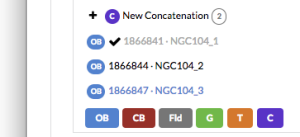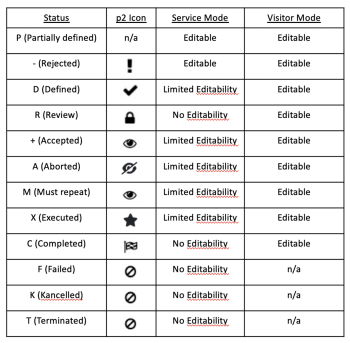Key concepts of Phase 2: OBs and scheduling container status
For operational reasons ESO has implemented a number of OBs and scheduling container status that indicate the operational stage in which a certain item is. These statuses define whether an OB is editable or not, is certified, reviewed and/or ready to be observed. Please see here for more information on these actions.
These statuses are coded in the user interface (UI) via the following conventions, which apply for OBs and scheduling containers too:

- General appearance
- an item is black: the OB/scheduling container is fully editable;
- an item is grey: the OB/scheduling container is read-only;
- an item is blue: selected item
- OB and scheduling container status

In the table on the left, users can find the list of the status flags and relative icons used in the p2 web application. Hereafter we give a more detailed definition of each status. Please notice that we identify with the term item both an OB and a scheduling container.
- P (Partially defined): the item has just been created on the ESO database. An unique ID identifies it and it is fully editable. The user can to run the verification test via the Check button to test the integrity of the item without changing its status;
- D (Defined): the item passed the certification (Certify) and is in principle ready for review. The item is only partially editable (item priority). The user can revise the status to P via the Revise button;
- - (Rejected): the item presents some problems and requires the attention of the user. The items becomes fully editable and the user must run check and certification on before being re-considered for the final approval;
- R (Review): the item is now under revision by the support astronomer in charge. This status is trigger when the user sends a notification to ESO that items are ready for review. At that point all and only the items that are in status D are changed to R;
- + (Accepted): the item is accepted and ready to be observed;
The user working in Service Mode should note that whenever the status allows "Limited Editability", the only parameter that can be edited is the user prioriry on the "Schedule" tab. All other parameter remains not editable.
The following status flags only apply to OBs:
- C (Completed): the item has been executed and successfully completed at the telescope and hence will not be repeated;
- X (Executed): the item has been executed and successfully completed at the telescope but can be repeated (e.g. Visitor's OBs);
- M (Must repeat): the item has been executed but outside the specified constraints. This item will be re-inserted in the Service Mode queue to be executed at a later time;
- A (Aborted): the item was aborted during execution. It will be re-inserted in the Service Mode queue to be executed at a later time;
- F (Failed): this status is specifically set when an OB containing absolute time widow(s) or being part of a time-linked container, and having acquired the absolute time window due to execution of the previous OB, expires; i.e. when its absolute time window(s) is(are) in the past. Failed OBs are read-only and cannot be executed! This status is irreversible.
- K (Kancelled): this status is set by the support astronomer for the OBs are incorrect but for some reason were not revised/deleted. OBs with status K is irreversible.
- T (Terminated): this status is set by the support astronomer for the OBs that belong to runs that have been Terminated at the end of the observing period because the run is not eligible for carryover status. OBs with status T is irreversible.
